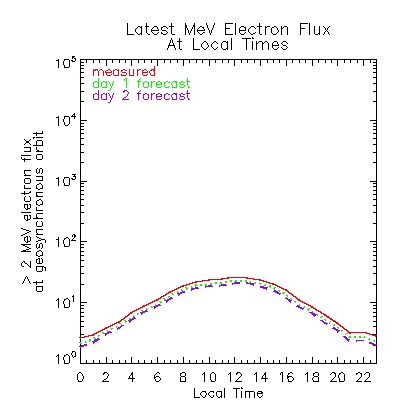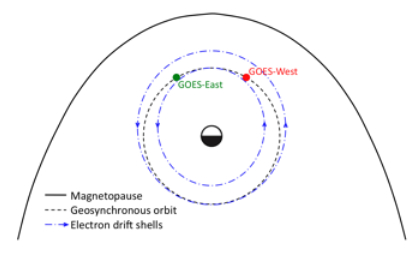Forecasts of Energetic Electrons at Geosynchronous Orbit


Time of model run: 2020/070-19:06:27
This website covers the results from a system of forecast tools that have been developed
for relativistic electron flux at geosynchronous orbit (GEO). The main plot above shows
the comparision of > 2 MeV electron flux measured by GOES-11 with forecast results.
The forecast shown is a weighted average of three independent forecast models, which include
solar wind measurements, a seed population, and an internal source.
The individual models and their weights for this run are discussed
here.
 The shaded envelope shows the range of fluxes that can be expected as a spacecraft passes
through different local hours around GEO (see schematic on the right).
This range is estimated using flux mapping with statistical asynchronous regression (SAR).
The smaller plot above shows the last measured, day 1 and day 2 forecast flux values
mapped to each local hour using SAR. The SAR technique captures the local time dependency
of the electron fluxes due to the asymmetry of the magnetosphere, using statistics
compiled from GOES flux and solar wind velocities from 1995 - 2009.
The shaded envelope shows the range of fluxes that can be expected as a spacecraft passes
through different local hours around GEO (see schematic on the right).
This range is estimated using flux mapping with statistical asynchronous regression (SAR).
The smaller plot above shows the last measured, day 1 and day 2 forecast flux values
mapped to each local hour using SAR. The SAR technique captures the local time dependency
of the electron fluxes due to the asymmetry of the magnetosphere, using statistics
compiled from GOES flux and solar wind velocities from 1995 - 2009.
For more discussions and the
Dst index prediction, see
[Temerin and Li, 2002; 2006; Li et al., 2001b].
These and other papers are available
here.
Monthly plots of predicted MeV electron flux and solar wind data from 2000 to the present are available in this
archive.
DSCOVR real-time solar wind plots are available for the
last 30 days
and the
last 96 hours.
For further information, contact Xinlin Li.
 The shaded envelope shows the range of fluxes that can be expected as a spacecraft passes
through different local hours around GEO (see schematic on the right).
This range is estimated using flux mapping with statistical asynchronous regression (SAR).
The smaller plot above shows the last measured, day 1 and day 2 forecast flux values
mapped to each local hour using SAR. The SAR technique captures the local time dependency
of the electron fluxes due to the asymmetry of the magnetosphere, using statistics
compiled from GOES flux and solar wind velocities from 1995 - 2009.
The shaded envelope shows the range of fluxes that can be expected as a spacecraft passes
through different local hours around GEO (see schematic on the right).
This range is estimated using flux mapping with statistical asynchronous regression (SAR).
The smaller plot above shows the last measured, day 1 and day 2 forecast flux values
mapped to each local hour using SAR. The SAR technique captures the local time dependency
of the electron fluxes due to the asymmetry of the magnetosphere, using statistics
compiled from GOES flux and solar wind velocities from 1995 - 2009.

